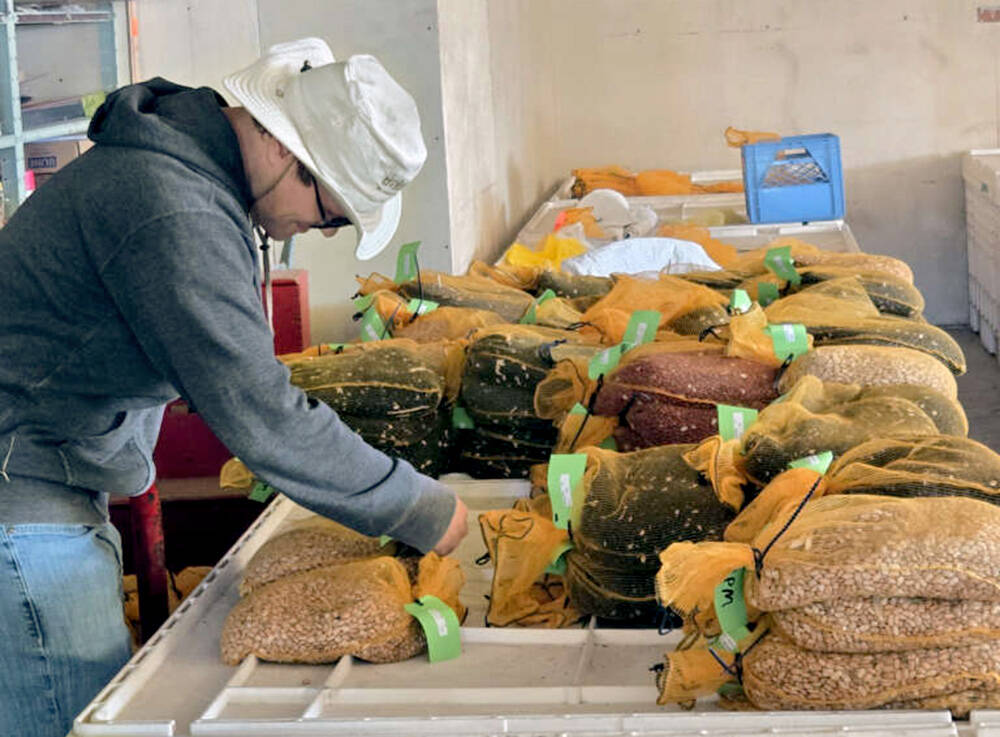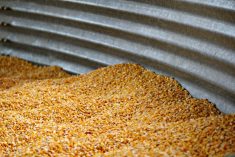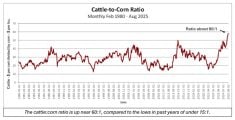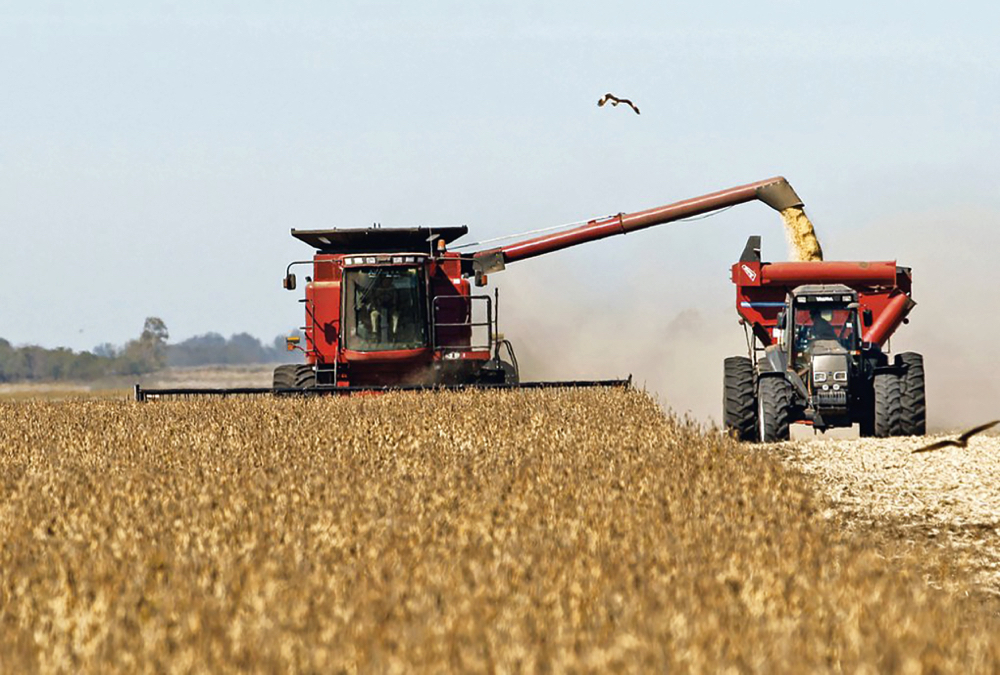Ontario farmers had harvested approximately 50 per cent of the soybean crop and 10 per cent of the corn as of Oct. 4. The 14-day weather forecast for southern Ontario calls for average temperatures and minimal precipitation. Average to above average precipitation is in the forecast for the latter half of October, which may result in yield drag on corn.
Yield reports confirm Statistics Canada’s production estimates, with some farmers reporting better than expected results. Large crops tend to become bigger. Ontario corn, soybean and wheat markets are functioning to encourage offshore movement. Elevator bids on all three crops are discount to world values so the downside is limited and we’re expecting prices for all three crops to rally into November.
Quick look
Soybeans: We believe factoring in optimal conditions in South America in the market is optimistic.
Corn: Early yield reports suggest the Ontario crop could come in at 10 million tonnes.
Wheat: Given tensions between Russia and Ukraine, it is unknown whether the current export agreement will continue through mid-November.
Read Also

Bean research breeds community giving
University of Guelph dry bean researcher Dr. Mohsen Yoosefzadeh Najafabadi champions sustainability by donating surplus breeding program beans to support food security and community art initiatives.
The United States Department of Agriculture released its Quarterly Stocks Reports and Small Grains Production Summary on Sept. 30. Soybean stocks as of Sept. 1 were higher than expected while corn stocks were lower than pre-report estimates. U.S. wheat production came in lower than expected and provided a bullish sentiment for the overall wheat complex.
Argentine and Brazilian farmers are in the early stages of planting. Argentina is experiencing drier conditions while Brazil has experienced regular rains resulting in favourable conditions. Australia’s wheat crop has received timely rains that enhance yield potential.
The wheat market continues to contend with geopolitical issues from the Black Sea region. Russia has a monster crop but its exports are sharply lagging year-ago levels.
The Canadian dollar continues to trend lower. From June 1 through Aug. 31, Canada lost 106,000 jobs, of which 90,000 were full-time positions. U.S. employers added 1.1 million jobs in August. Energy and gas prices have softened and wage growth is now a major contributor of inflation. Interest rate hikes from the Bank of Canada will likely top out at 4.5 per cent early in the first quarter of 2023; however, upward adjustments from the U.S. Federal Reserve will likely reach five per cent in March/April 2023.
A weaker Canadian dollar will continue to enhance export demand for Ontario corn, soybeans and wheat. Energy prices may experience a significant rally after the U.S. crude oil stocks release program ends in the latter half of October. U.S. crude oil stocks are at dangerously low levels. It is important to top up your tanks and have about three months of fuel storage on farm.
Soybeans
We feel comfortable with Statistics Canada’s production estimate of 4.111 million tonnes. This compares to last year’s crop size of 4.082 million tonnes and the five-year average output of 3.9 million tonnes. We expect Ontario farmers to deliver three million tonnes from Sept. 1 through Dec. 31.
The domestic crush for the four-month period will reach 600,000 tonnes, while exports are expected to finish near 1.9 million tonnes. This reflects that export values will provide the underlying floor price through fall and early winter. Domestic processing margins are quite healthy, encouraging the local crush pace.
At the time of writing this article, Brazilian soybeans f.o.b. Paranagua and U.S. soybeans f.o.b. the Gulf were both priced at US$590/tonne. Ontario soybeans f.o.b. St. Lawrence port were quoted at $570/tonne. Ontario soybeans are reflecting a healthy discount to the world market during the harvest period.
U.S. export basis will likely come under pressure over the next month as harvest progresses. Fobbing capacity will become an issue out of the Gulf later in fall as U.S. soybean export sales are running 10 per cent above year-ago levels. China recently purchased a large volume of soybeans from Argentina and Brazil, covering the bulk of its import demand through December.
U.S. soybean ending stocks for the 2021-22 crop year came in at 274 million bushels or 7.5 million tonnes on the USDA Sept. 1 Stocks Report. Ending stocks are not as tight as earlier anticipated. Given the current forecast, the U.S. soybean harvest will wrap up in a timely fashion without significant delays. Trade estimates are comfortable with the USDA production estimate of 119 million tonnes, down one million tonnes from last year.
Argentine and Brazilian farmers are in the early stages of planting the upcoming crop. We expect the soybean market to incorporate a risk premium later in fall given the drier conditions in Argentina. Certain regions of Brazil are also susceptible to adverse weather. At this stage, the market is factoring in optimal conditions in South America and we believe this is somewhat optimistic.
What to do: We are expecting the crude oil market to stage a significant rally over the winter. This will result in significant fund buying of soybean futures and further enhance the crush margin structure. We’ve advised farmers to be 20 per cent sold on their 2022 production. We expecting the soybean market to percolate higher through the fall, allowing us to be more aggressive on sales in November.
Corn
Statistics Canada estimated the Ontario corn crop at 9.804 million tonnes. Early yield reports suggest the corn crop could reach 10 million tonnes, up from 9.5 million tonnes last year and up from the five-year average of 8.9 million tonnes. Ontario corn exports from Sept. 1 through Dec. 31 are expected to reach 600,000 tonnes. Domestic demand during the same time is estimated to finish near 2.7 million tonnes. Total demand is 3.3 million tonnes.
Ontario farmers are expected to sell 6.3 million tonnes during the first four months of the crop year. This will keep Ontario elevator bids discount to world values as the market functions to encourage demand.
At the time of writing this article, Brazilian corn was quoted at US$285/tonne f.o.b. Paranagua, while U.S. corn was valued at $322/tonne f.o.b. the Gulf. Ontario corn f.o.b. St. Lawrence port was quoted at $290/tonne. French corn was quoted at $360/tonne f.o.b. La Pallice and German corn was quoted at $344/tonne delivered Hamburg.
Ontario corn has a favourable advantage to Northern European ports and to Spain. We believe Ontario corn could significantly expand market share in Europe this fall by trading into non-traditional European destinations. Our export projection for the first four months of the crop-year may be on the low side.
U.S. corn stocks as of Sept. 1 came in at 1.377 billion bushels or 35 million tonnes on the USDA Quarterly Stocks Report. This was below pre-report estimates. Given the tighter carryout from the 2021-22 crop year, the market has become more sensitive to yield and production estimates.
Contrary to Ontario, early reports from the U.S. suggest the crop is not as big as earlier anticipated. These reports come after the USDA lowered its corn estimate to 354 million tonnes, down 20 million tonnes from last year. The U.S. corn market is rationing demand as export values are premium to South America and Ontario. U.S. export sales for the 2022-23 crop year are running 50 per cent below year-ago levels.
Argentinian farmers are in the early stages of corn planting. Conditions are on the drier side and timely rains are needed over the next month to help the early planted crop. Brazil’s first crop corn will be planted under favourable conditions but the focus for Brazil is the second corn crop planted in February.
What to do: We have advised Ontario farmers to be 20 per cent sold on their 2022 production. We’re planning on making our next sale in November once harvest is wrapped up. We believe there is potential for the corn market to incorporate a risk premium due to the uncertainty in U.S. production and drier conditions in Argentina. There is limited downside risk from current levels for Ontario corn given the discount to world values.
Wheat
Ontario farmers harvested two million tonnes of winter wheat this summer, down from last year’s output of 2.7 million tonnes and down from the five-year average of 2.1 million tonnes. Ontario farmers will sell nearly 1.7 million tonnes during the first five months of the crop year. We’re strong advocates to sell regular increments throughout the crop year.
At the time of writing this article, Ontario soft red winter wheat bids were averaging $11/bushel, up $1.50/bushel from two weeks earlier. There is a strong seasonal tendency for the wheat market to rally from Sept. 15 through Nov. 15.
The USDA Small Grains Production Summary was considered bullish for the wheat market. U.S. hard red winter production came in at 14.5 million tonnes, down from the August estimate of 15.7 million tonnes and down from the five-year average of 21.8 million tonnes. U.S. hard red winter wheat stocks will be historically tight at the end of the 2022-23 crop year. The market needs to seriously ration demand.
U.S. soft red is 9.2 million tonnes, down from the August estimate of 10.4 million tonnes but up from the five-year average of 7.9 million tonnes. North American soft red winter wheat prices will be pulled up by the hard red winter values. The lower U.S. production estimates come on the heels of drier conditions in Argentina, which have trimmed production estimates. Australian wheat conditions are favourable but we are still expecting a year-over-year decrease in production.
Russian President Vladimir Putin and the international community have agreed to allow exports from Ukraine through mid-November. It is difficult to say whether this agreement will be renewed given the high tensions. Ukraine has been exporting wheat through other channels but it’s not as efficient. Russia’s 2022 wheat production could reach a record 100 million tonnes. Exports are sharply lagging year-ago levels. In previous years Russian wheat traded into Mexico and Central and South America. This year, we are not seeing that trade flow.
The wheat market has factored in the absence of large-scale Russian exports. We could see the wheat market incorporate a risk premium if the export agreement is not renewed during November.
What to do: We advise Ontario farmers to only be 10 per cent sold on their 2022 wheat production. We are planning to make our next sales recommendation in late October or early November depending on the market structure. There is a fair amount of risk in the wheat market, which favours additional upside.













